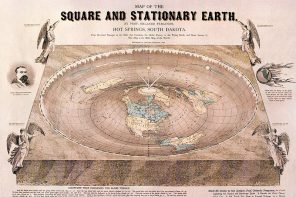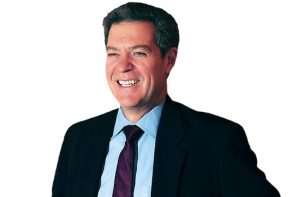Death is not final.
Last week, four scientific big thinkers settled into their seats on stage at NYC’s Kaufmann Center to debate this provocative proposition for NPR’s Intelligence Squared. They would be discussing this proposition from a purely scientific, not a religious point of view, wrestling with the fundamental question of whether or not consciousness is totally contingent on a functioning human brain.
And if it is not, so the logic goes, then the demise of the brain does not deal a fatal blow to consciousness—therefore, death is not the end.
Variations of this conversation are breaking out all over, from the fascinating argument between Jeffrey Kripal and Jerry Coyne (Coyne declared Kripal to be a “science-basher” for wanting to widen the field of human knowledge to include mystical experience) to lively discussions around Barbara Eherenreich’s newest book, to the recent attack by Cardinal Gerhard Müller on the Leadership Conference of Women Religious.
In this instance, the cardinal attacked the sisters for daring to invite unapproved, heretical speakers to its annual conference, specifically that maven of “conscious evolution” Barbara Marx Hubbard, who spoke in 2012. In response, the National Catholic Reporter’s Thomas C. Fox wrote an impassioned defense of LCRW’s choices as reflections of Pope John Paul II’s commitment to ongoing efforts to reconcile science and religion. And Hubbard herself followed up in NCR with a strong argument for what she sees as the essential relationship between conscious evolution and Catholicism.
On the night of the “death” debate, in an extremely civil conversation—the hallmark of these Oxford Style debates, tightly moderated by NPR’s John Donvan—neurosurgeon Eban Alexander, author of the best-selling Proof of Heaven, issued the first salvo. He recounted his journey into the afterlife while in a week-long coma, from a gloomy, muddy locale, where he had nothing but an “earthworm’s eye-view,” onto the wings of a blue butterfly with a beautiful blonde girl into the gorgeous Gateway and finally the Core, where he met Om, or God. His story became Exhibit A, the night’s live example of consciousness that persists independent of a functioning brain.
Supporting Alexander’s position was physician-philosopher Dr. Raymond Moody, author of Life After Life (in which he coined the term “Near Death Experience”). Not only did Moody bring tidings of his thousands of interviews with people who had NDEs; he also claimed that he has come to know hundreds of people who have had similar experiences to the person having the NDE, even though they themselves were nowhere near death.
All of the elements that we think of as a near-death experience, getting out of the body, going into this light, seeing a panoramic review of one’s life, seeing apparitions of the deceased occur very commonly, not just to people who almost die and are brought back, but rather to the healthy and uninjured bystanders at the bedside of someone else—shared death experiences, I call them.”
Challenging Alexander and Moody was Sean Carroll, physicist, cosmology researcher, author of The Particle at the End of the Universe. He pointed out how prone we humans are to believing what we want to believe—like stories of mystical experiences. He’s never seen anyone bring back from one of those experiences something valuable that we didn’t know, like a cure for Alzheimer’s, for example. And these experiences are widely observed to be culturally conditioned:
When Christians have near-death experiences, they often say they’ve met Jesus. When Hindus have near-death experiences, they meet Hindu deities. There was a little girl who had a near-death experience, and she met a portly man wearing a red cap. She met Santa Claus.
His argument was bolstered by his co-panelist, Dr. Steven Novella, academic clinical neurologist at the Yale School of Medicine, host of podcast “The Skeptic’s Guide to the Universe.” Novella argued that “our brains are narrative-generating machines.” Our brains construct our reality; damaged brains distort it. “The mind is a process of the brain itself,” he said. “Everything that you think, feel, believe, is something that’s happening inside the brain, demonstrably.”
Carroll and Novella dismissed NDEs as experiences that can be duplicated with drugs and oxygen deprivation. But what about those shared death experiences, mediums and other paranormal phenomenon?
While acknowledging that evidence exists for and against such things, Carroll said,
The kind of remote seeing or telepathy or telekinesis or clairvoyance that is being talked about here is in utter and complete violation of everything we understand about the current laws of physics, the fundamental way that matter and energy work.
That demands that the evidence for such things must be “amazingly good,” he added, and today, “the evidence in favor of psychic phenomena comes nowhere near that standard.”
“My response is that the evidence for things like telepathy, precognition, remote viewing, out of body experiences, past life memories in children, the after-death communications is overwhelmingly positive evidence, that it exists and is real,” insisted Alexander in reply.
Each side made a strong case, but each side also got its comeuppance. The sharpest poke in Alexander’s story—which comes on the heels of Luke Dittrich’s devastating Esquire piece that presented Alexander as an unreliable narrator—concerned what Alexander claimed was the timing of his journey into the dark world of Om. The renowned neurosurgeon claimed that it occurred during the middle days of his coma, when his neocortex was not functioning. But how does he know that? asked Novella. How does he know it didn’t occur in the first hours of his coma or when he was coming out—when arguably his brain would have been more functional?
Try as he might, Alexander could not put that question to rest.
The statement that set Novella to stammering came from Alexander, who repeatedly asserted that “there is no neurosurgeon on the planet who can say where consciousness comes from.” Novella made a valiant effort to swat away that reality—
we don’t know exactly how the brain generates consciousness…not knowing the mechanism is not the same thing as saying it’s not possible…we’re certainly not all the way there in understanding exactly what it is…it’s not a black and white thing.
Without admitting so directly, his equivocation suggested that Alexander had it right.
After two hours of jousting, it was time to declare a winner. At these debates, everyone in the audience has a keypad attached to their seat where they can vote on the proposition before the debate begins, and after it ends—do they agree with the proposition, disagree with the proposition, or are they undecided. The side that creates the greatest change in positions wins.
When this audience started out, 37% accepted the proposition that “death is not final,” 31% rejected it, and 32% were undecided. At the end of the debate, there were only 12% undecideds. Those who believe that death is not final increased by 5% to 42%. But the winners—if you can call it that—were the skeptics who believe that death is indeed final; their numbers increased by 15% to 46%.
It’s true that 42% and 46% are not that far apart. It may be that Moody offered a bridge between the two sides.
Summing up the “death as final” side, Carroll said:
The question is not, Is it conceivable that there are other realms? The question is: Is the evidence in favor of that other realm so overwhelming that it causes us to dismiss the enormous successes of physics, chemistry, biology and neuroscience?
To him and to likeminded others, of course, the answer is no.
Moody at first agreed, leading to premature jubilation from the other side. “No, it doesn’t require you to dismiss the findings of science,” he said. “Yet,” he added,
I think it’s entirely conceivable that there’s some other domain of existence over this that some people gain access to sometimes.
What I am suggesting is that the solution to the afterlife question is not going to come initially from science, but rather from the whole area of critical thinking and logic. In my opinion, we really are on the verge of breakthroughs in the genuine—and I will underline genuine—rational investigation of the question of life after death.




